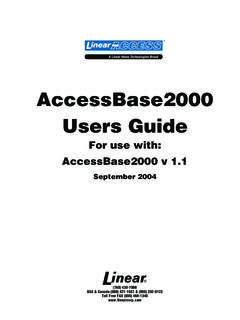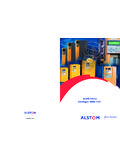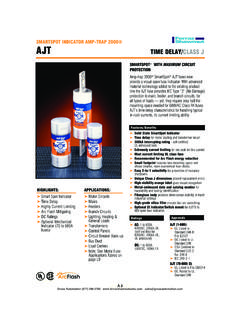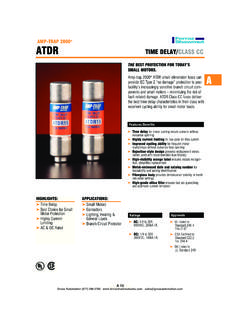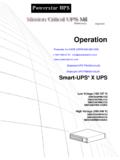Transcription of Moyno® 2000 Pumps (Serice Manual - G1 and G2 …
1 MOYNO 2000 Pumps G2 Open Throat Models G3 Bridge Breaker Models SERVICE Manual TABLE OF CONTENTS Page 1-1. 1-2. 1-3. NAMEPLATE 1-4. Pump 1-5. Model 1-6. Frame Size 1-7. Type 1-8. Trim 1-9. Variation of Standard 2-1. 2-2. 2-3. 2-4. Suction 2-5. Discharge 2-6. 2-7. SHAFT 2-8. On Coupling Connected 2-9. On Belt Drive 2-10. WATER FLUSH OF 3-1. 3-2. 3-3. 3-4. PACKING DRIVE ASSEMBLY 4-1. 4-2. 4-3. PACKING 4-4. PACKING 4-5. 4-6. 4-7. Gear 4-8. G3 4-9. DISASSEMBLY OF G2 OPEN THROAT 4-10. Disconnect 4-11. Packing 4-12. Stator 4-13. Rotor 4-14. Gear Joints and Conveyor Assembly Removal ..6 4-15. Drive Shaft and Bearings Removal6 4-16. DISASSEMBLY OF G3 BRIDGE 4-17. Disconnect 4-18. Chain 4-19. Torque Limiter 4-20. Shaft Gears 4-21. Breaker End Shafts or Paddle Assembly 4-22. Drive Assembly Shafts 4-23. Packing Page 4-24.
2 4-25. 4-26. 4-27. 4-28. 4-29. 4-30. 4-31. 4-32. All Other 4-33. ASSEMBLY OF G2 OPEN THROAT 4-34. Lubrication During 4-35. Packing 4-36. Bearing Housing/Suction Housing 4-37. Bearing/Drive Shaft 4-38. Rotor/Stator 4-39. Rotor Gear Joint and Conveyor 4-40. Drive End Gear Joint 4-41. Stator Support/Discharge 4-42. Final 4-43. Packing 4-44. ASSEMBLY OF G3 BRIDGE 4-45. Suction Flange 4-46. Packing 4-47. Mounting 4-48. Paddle Assembly 4-49. Drive Assembly 4-50. Final 4-51. 4-52. Short Term 4-53. Long Term 4-54. PACKING 4-55. VARIATIONS OF STANDARD 4-56. 4-57. Drive 4-58. STANDARD HARDWARE FOR G2 OPEN 4-59. SELECTING THE CORRECT 4-60. PARTS LIST FOR G2 OPEN 4-61. STANDARD HARDWARE FOR G3 BRIDGE 4-62. PARTS LIST FOR G3 BRIDGE 4-63. CONVERSION FROM G2 TO 4-64. SHAFT SLEEVE 4-65. 4-66. 4-67. Note: This service Manual outlines installation, operation and maintenance proce- dures for the open throat G2 and bridge breaker G3 models of the Moyno 2000 pump.
3 For information on the flanged (G1) models of the Moyno 2000 pump, refer to the G1 Service Manual , or contact your nearest Moyno pump representative. SERVICE Manual MOYNO 2000 Pumps G2 Open Throat Models G3 Bridge Breaker Models 1-1. INTRODUCTION 1-2. GENERAL The Moyno 2000 Pump is the culmination of over 50 years of experience in manufacturing and marketing fluids handling equipment. This rugged pump has been engineered to be the most reliable product ever sold under the Moyno name. The pump has been painstakingly tested to assure consistent performance in the most difficult of applications. It represents the next genera-tion of the world s most versatile pump. The Moyno 2000 Pump is a progressing cavity pump. The pumping action is created by a single helical rotor rolling eccentrically in the double helix of the stator. The rotor in conjunction with the stator forms a series of sealed cavities 180 degrees apart.
4 As the rotor turns, the cavities progress from the suction to the discharge. As one cavity diminishes, the opposing cavity increases at exactly the same rate. Thus the sum of the two discharges is a constant volume. The result is a pulsation-free positive displacement flow utilizing no valves. NAMEPLATE DATA The pump nameplate, located on the bearing housing, contains important information relating to the operation and servicing of the pump. This information includes the direction of rotation arrow and the pump model and serial numbers (see fig. 1-1). The pump model number must be used for reference when ordering spare parts. To simplify this procedure, the model number for your pump has been recorded on the nameplate drawing on the front cover of this Manual . Please carefully file this Manual for further reference. Pump Rotation. The direction of rotation is indicated by a rotation arrow on the nameplate. Rotation of Moyno 2000 G2/G3 Pumps is always clockwise, when viewed from the driven end of the pump.
5 1-5. Model Number. The pump model number consists of three component parts: Frame Designations, Type Designa-tions and a Trim Code. A typical model number for example, might be 2G065G2 CDQ AAA, as shown on the nameplate in fig. 1-1. 1-6. Frame Designation. The Moyno 2000 is modular in concept allowing for optimal matching of drive ends and Figure 1-1. Typical nameplate showing rotation arrow, model and manufacturing serial numbers. pump elements (rotor and stator) to meet the requirements of the application. The seven or more characters in the frame designation describe the particular combination of drive end and pump elements, as well as other construction details of your pump. The first character in the frame designation, always a number, indicates the number of stages of the pumping elements. The second character is always a letter (E through K) and indicates the drive end size. The third, fourth and fifth characters are numbers indicat-ing the theoretical capacity of the pumping elements per 100 revolutions.
6 The sixth character represents the type of universal joint utilized. The letter G indicates a gear type joint. Other con-figurations may be indicated by the letters P or F. The seventh character, a number, indicates the type of suction housing. Flanged suction port Pumps are designated by the numeral 1, open throat Pumps by the numeral 2 and open throat Pumps with a bridge breaker option by the numeral 3. 1-7. Type Designation. Following the Frame Designa-tion is the Type Designation, a series of three letters describ-ing the materials from which the pump is constructed. Section: MOYNO 2000 Pumps Page: 1 Date: May 15, 1997 Page 2 The first letter identifies the material of the suction housing. C Cast Iron E Carpenter 20 Stainless Steel H Hastelloy C M Monel S 316 Stainless Steel W Cast Steel X Special to application Note: The bearing housing of the pump is always made of cast iron. The second letter indicates the material used in the drive shaft, connecting rod, rotor and other wettable parts.
7 D Alloy Steel E Carpenter 20 Stainless Steel G 416 Stainless Steel H Hastelloy C J 17-4 PH Stainless Steel M Monel S 316 Stainless Steel X Special to application The third letter indicates the material of the stator. It identi-fies only the stator material and not that of the tube in which the stator is placed, which is always carbon steel. Standard stator materials used in the Moyno 2000 pump are as fol-lows: B EPDM 300, 70 Durometer C Nitrile 103, 50 Durometer D Tool Steel E Nitrile 110, 70 Durometer F Fluoroelastomer 500, 75 Durometer G 416 Stainless Steel H Hastelloy C J 17-4 PH Stainless Steel K Hypalon 800, 70 Durometer M Nitrile 100M 70 Durometer P Thiokol 70 Durometer Q Nitrile 100, 70 Durometer R Natural Rubber 200, 55 Durometer T Teflon 15% glass U Urethane 70 Durometer X Special to application Z White Nitrile 150,70 Durometer A typical type designation such as CDQ, would identify the following materials of construction: C = Cast iron suction housing D = Alloy steel rotor, drive shaft, connecting rod and other minor metallic parts in con-tact with the fluid being pumped.
8 Q = Nitrite (70 durometer) stator 1-8. Trim Code. Also included in the Model Number is the three character Trim Code which is used to identify pump construction. The letters AAA signify standard construction, with letters other than A signifying variations. The first letter identifies sealing variations; the second, internal variations; and the third, rotor variations. 1-9. Variations of Standard Parts. Refer to Sections 4-55 thru 4-57 for variations available for modifying Pumps to meet specialized pumping conditions. If the trim code of your pump is other than AAA, contact your nearest Moyno rep-resentative for clarification. Do not modify your pump with any variation unless you have determined that it is compat-ible with your application. 2-1. INSTALLATION GENERAL Moyno Pumps are lubricated and tested at the factory prior to shipment and require minimum pre-start up maintenance. Accessibility to the pump and adequate clearance should be a prime consideration in any installation.
9 Enough space should surround the unit so that maintenance can be car-ried out with ease. 2-3. PIPING 2-4. Suction hopper used with open throat and bridge breaker Pumps should have nearly vertical sides, or be oth-erwise designed to enhance the flow of the material into the pump. 2-5. Discharge piping diameter should generally be as large as the pump ports unless fluid conditions indicate otherwise. An easily removable section of piping one-to-two times longer than the connecting rod should be mated to the dis-charge port. This will allow the rotor and stator to be re-moved without having to remove the complete pump from the base. 2-6. FOUNDATION For maximum pump-driver unit life, each unit should be mounted on a strong, fabricated-steel base plate which can be ordered from Moyno. The base plate should be mounted on a concrete foundation built on a solid base. The foundation should be approximately 4 to 8 longer and wider than the base for which it is built.
10 (See fig. 2-1.) Anchor bolts for the base plate should be located in the foundation. Figure 2-1. Typical Foundation Example Check the base plate surface with a carpenter s level and place shims under the base plate at the places necessary to make it level. Then check the pump, driver shaft and the pump ports to ensure that they are level. Complete base mounted units supplied by Moyno including pump and driver are leveled with respect to the base at the factory. Shifting may occur during shipment. The pump and driver should be realigned. Care should be exercised to en-sure that all components are level and mounted in a direct line. For maximum rigidity and lower noise levels the base plate should be grouted to the foundation after the anchor bolts have been evenly tightened. A good grade of non-shrink grout is recommended. The spaces between the base plate and the foundation around the shims should also be filled with grout.

